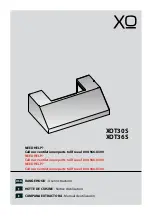
PROBLEM
POSSIBLE CAUSE
OVEN TEMPERATURE
• Oven thermostat needs adjustment. See the Adjust the Oven Thermostat—
TOO HOT OR TOO COLD
Do It Yourself section.
“BURNING” OR “OILY”
• This is normal in a new oven and will disappear in time. To speed the process,
ODOR EMITTING FROM
set a self-clean cycle for a minimum of 3 hours. See the Operating the
OVEN WHEN TURNED ON
Self-Cleaning Oven section.
STRONG ODOR
• An odor from the insulation around the inside of the oven is normal
for the first few times the oven is used. This is temporary.
SURFACE UNITS WILL NOT
• You must use pans which are absolutely flat. If light can be seen between
MAINTAIN A ROLLING
the pan bottom and a straight edge, the elements will not transfer heat properly.
BOIL OR FRYING RATE
• Pan bottoms should closely match the diameter of the surface unit selected.
IS NOT FAST ENOUGH
COOKTOP FEELS HOT
• The glass cooktop surfaces may seem hotter than you are used to.
This is normal. Make sure flat-bottomed pans are used.
FOODS COOK SLOWLY
• Improper cookware being used. Pan bottoms should be flat, fairly heavy weight
and the same diameter as the surface unit selected.
SURFACE UNITS DO
• Difficulty may be in the main distribution panel of your house, caused by a
NOT WORK PROPERLY
blown oven-circuit fuse, a tripped oven-circuit breaker, the main fuse or the
main circuit breaker, depending on the nature of the power supply. If a circuit
breaker is involved, reset it. If the control box uses fuses, the oven fuse
(a cartridge-type) should be changed, BUT ONLY BY SOMEONE FAMILIAR
WITH ELECTRICAL CIRCUITS. If after performing one of these procedures,
the fuse blows or circuit breaker trips again, call for service.
NOTE: Apartment tenants or condominium owners should ask their building
management to perform this check before calling for service.
• Cooktop surface unit controls are not properly set, or the wrong control knob
is set for the surface unit you are using.
TINY SCRATCHES
• Incorrect cleaning methods have been used, cookware with rough bottoms
(may appear as cracks) OR
has been used, or coarse particles (salt or sand) were between the cookware
ABRASIONS ON RADIANT
and the surface of the cooktop. Use recommended cleaning procedures, be sure
COOKTOP GLASS SURFACE
cookware bottoms and cookware are clean before use, and use cookware with
smooth bottoms. Tiny scratches are not removable but will become less visible
in time as a result of cleaning.
METAL MARKINGS
• Do not slide aluminum cookware across the surface. Use recommended
(may appear as scratches)
cleaning procedure to remove marks.
• Incorrect cleaning materials have been used, encrusted boilovers or grease
spatters remain on the surface. Use a razor scraper and recommended
cleaning procedure.
DARK STREAKS OR SPECKS
• Use a razor scraper and recommended cleaning procedure.
AREAS OF
• Marks from aluminum and copper pans as well as mineral deposits from water
DISCOLORATION
or food can be removed with Cook Top Cleaning Creme.
ON COOKTOP
HOT SUGAR MIXTURES/
• See the Glass Ceramic Cooktop Cleaning section.
PLASTIC MELTED TO
THE SURFACE
FREQUENT CYCLING
• Incorrect cookware used. Use only flat cookware to minimize cycling.
OFF AND ON OF
SURFACE UNITS
34
THE PROBLEM SOLVER
(continued)



































